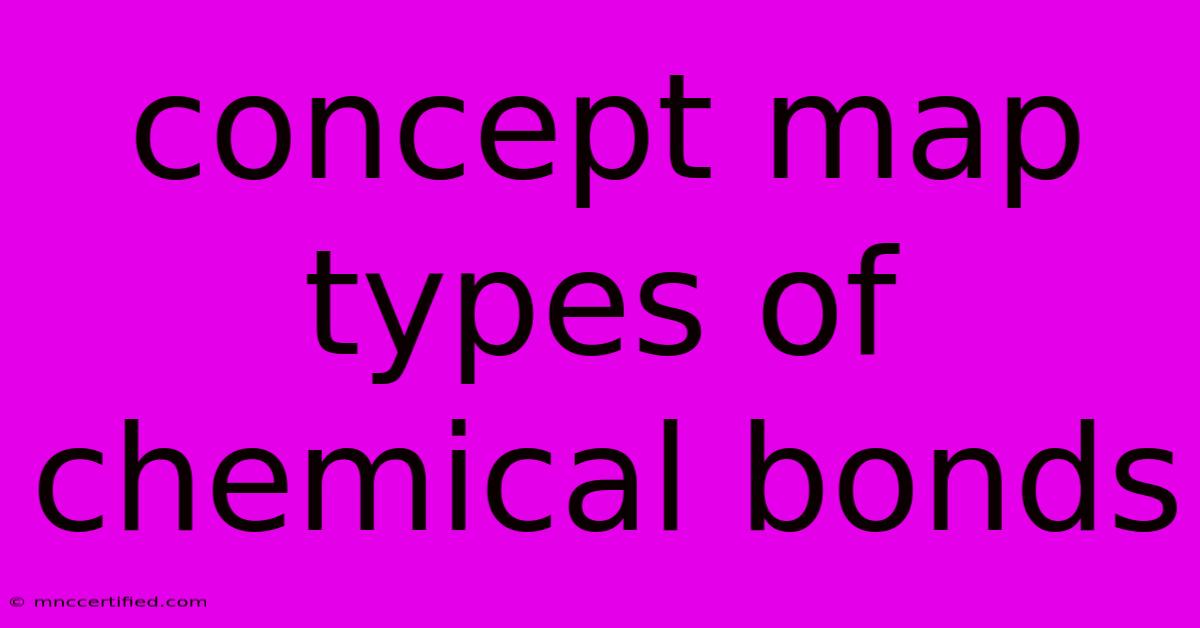Concept Map Types Of Chemical Bonds

Table of Contents
Demystifying Chemical Bonds: A Concept Map Journey
Understanding chemical bonds is fundamental to comprehending the behavior of matter. From the simplest molecules to complex biological systems, chemical bonds hold atoms together, forming the building blocks of everything around us. This article will delve into the fascinating world of chemical bonds using a concept map approach to clarify the different types and their key characteristics.
Concept Map: Types of Chemical Bonds
This concept map visualizes the key categories of chemical bonds and their defining features:
Chemical Bonds
/ \
/ \
Ionic Bonds Covalent Bonds
(Electrostatic) (Sharing Electrons)
/ \ / \
/ \ / \
Metallic Bonds Polar Covalent Nonpolar Covalent
(Electron Sea) (Unequal Sharing) (Equal Sharing)
|
|
Hydrogen Bonds
(Special Interaction)
Let's explore each type in detail:
1. Ionic Bonds:
- Definition: Ionic bonds form when one or more electrons are transferred from one atom to another, resulting in the formation of oppositely charged ions.
- Key Features:
- Electrostatic attraction: The oppositely charged ions attract each other strongly, forming a stable ionic compound.
- Metal and Nonmetal: Ionic bonds typically involve a metal element and a nonmetal element.
- High Melting and Boiling Points: The strong electrostatic forces require a significant amount of energy to break the bonds, leading to high melting and boiling points.
- Good Electrical Conductors: When dissolved in water, ionic compounds dissociate into ions, allowing for the flow of electricity.
Example: Sodium chloride (NaCl), commonly known as table salt, is a classic example of an ionic compound. Sodium (Na) loses an electron to become a positively charged ion (Na+), while chlorine (Cl) gains an electron to become a negatively charged ion (Cl-). The electrostatic attraction between these ions forms the ionic bond.
2. Covalent Bonds:
- Definition: Covalent bonds are formed when two or more atoms share electrons.
- Key Features:
- Sharing electrons: Atoms share electrons to achieve a stable electron configuration.
- Nonmetal and Nonmetal: Covalent bonds typically involve nonmetal elements.
- Lower Melting and Boiling Points: Compared to ionic compounds, covalent compounds have lower melting and boiling points due to weaker intermolecular forces.
- Poor Electrical Conductors: Covalent compounds are generally poor electrical conductors as they lack free-moving ions.
Types of Covalent Bonds:
-
Polar Covalent Bonds: When electrons are shared unequally between atoms due to differences in electronegativity, a polar covalent bond is formed.
- Unequal sharing: The atom with higher electronegativity attracts the shared electrons more strongly, creating a partial negative charge on that atom and a partial positive charge on the other.
- Example: Water (H2O), where oxygen is more electronegative than hydrogen, resulting in a polar covalent bond.
-
Nonpolar Covalent Bonds: When electrons are shared equally between atoms, a nonpolar covalent bond is formed.
- Equal sharing: Atoms with similar electronegativity share electrons equally.
- Example: Diatomic molecules like oxygen (O2) and nitrogen (N2) have nonpolar covalent bonds.
3. Metallic Bonds:
- Definition: Metallic bonds occur between metal atoms where electrons are delocalized and can move freely throughout the entire structure.
- Key Features:
- Electron Sea Model: The free-moving electrons form a "sea" of electrons that surrounds the positively charged metal ions.
- Strong Bonds: Metallic bonds are generally strong, giving metals their high melting and boiling points, ductility, and malleability.
- Good Electrical Conductors: The delocalized electrons can easily carry electrical current.
Example: Copper (Cu) is a good conductor of electricity due to its free-moving electrons in a metallic bond.
4. Hydrogen Bonds:
- Definition: Hydrogen bonds are a special type of intermolecular force that occurs between a hydrogen atom covalently bonded to a highly electronegative atom (like oxygen or nitrogen) and another electronegative atom.
- Key Features:
- Stronger than Van Der Waals forces: They are stronger than other intermolecular forces, playing a crucial role in properties like water's high boiling point and DNA's double helix structure.
Example: Water molecules form hydrogen bonds with each other, leading to its unique properties like high surface tension and high specific heat capacity.
Conclusion:
By understanding the different types of chemical bonds and their defining characteristics, we can better comprehend the structure and properties of molecules and materials. This concept map serves as a helpful tool for visualizing these essential concepts in chemistry.

Thank you for visiting our website wich cover about Concept Map Types Of Chemical Bonds. We hope the information provided has been useful to you. Feel free to contact us if you have any questions or need further assistance. See you next time and dont miss to bookmark.
Featured Posts
-
Clark County Pays Tribute To Marine
Nov 12, 2024
-
Spinnaker Insurance Company Reviews
Nov 12, 2024
-
Bonding Inquiry Activity Answer Key
Nov 12, 2024
-
Jones Bristles Lamb Throws Shade On Curtains
Nov 12, 2024
-
Andrew Mccarville Fisher Investments
Nov 12, 2024